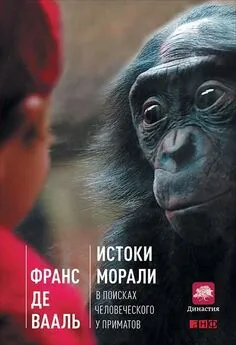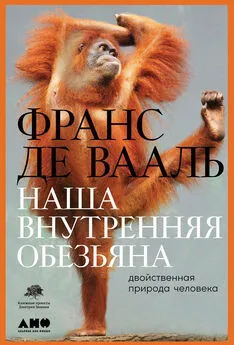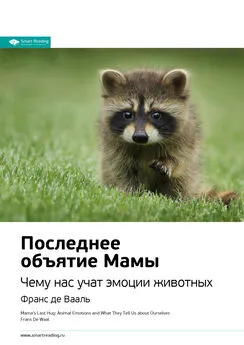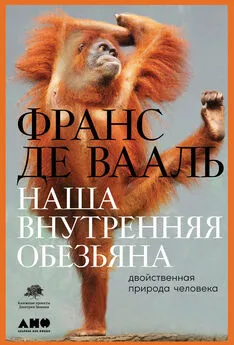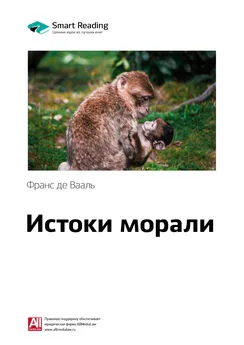Франс де Вааль - Достаточно ли мы умны, чтобы судить об уме животных?
- Название:Достаточно ли мы умны, чтобы судить об уме животных?
- Автор:
- Жанр:
- Издательство:ЛитагентАльпина6bdeff1e-120c-11e2-86b3-b737ee03444a
- Год:2017
- Город:Москва
- ISBN:978-5-9614-4452-0
- Рейтинг:
- Избранное:Добавить в избранное
-
Отзывы:
-
Ваша оценка:
Франс де Вааль - Достаточно ли мы умны, чтобы судить об уме животных? краткое содержание
В течение большей части прошедшего столетия наука была чрезмерно осторожна и скептична в отношении интеллекта животных. Исследователи поведения животных либо не задумывались об их интеллекте, либо отвергали само это понятие. Большинство обходило эту тему стороной. Но времена меняются. Не проходит и недели, как появляются новые сообщения о сложности познавательных процессов у животных, часто сопровождающиеся видеоматериалами в Интернете в качестве подтверждения.
Какие способы коммуникации практикуют животные и есть ли у них подобие речи? Могут ли животные узнавать себя в зеркале? Свойственны ли животным дружба и душевная привязанность? Ведут ли они войны и мирные переговоры? В книге читатели узнают ответы на эти вопросы, а также, например, что крысы могут сожалеть о принятых ими решениях, воро́ны изготавливают инструменты, осьминоги узнают человеческие лица, а специальные нейроны позволяют обезьянам учиться на ошибках друг друга. Ученые открыто говорят о культуре животных, их способности к сопереживанию и дружбе. Запретных тем больше не существует, в том числе и в области разума, который раньше считался исключительной принадлежностью человека.
Автор рассказывает об истории этологии, о жестоких спорах с бихевиористами, а главное – об огромной экспериментальной работе и наблюдениях за естественным поведением животных. Анализируя пути становления мыслительных процессов в ходе эволюционной истории различных видов, Франс де Вааль убедительно показывает, что человек в этом ряду – лишь одно из многих мыслящих существ.
Достаточно ли мы умны, чтобы судить об уме животных? - читать онлайн бесплатно ознакомительный отрывок
Интервал:
Закладка:
Mercader, J., et al. 2007. 4,300-year-old chimpanzee sites and the origins of percussive stone technology. Proceedings of the National Academy of Sciences USA 104:3043–48.
Miklósi, Á., et al. 2003. A simple reason for a big difference: Wolves do not look back at humans, but dogs do. Current Biology 13:763–66.
Mischel, W., and E. B. Ebbesen. 1970. Attention in delay of gratification. Journal of Personality and Social Psychology 16:329–37.
Mischel, W., E. B. Ebbesen, and A. R. Zeiss. 1972. Cognitive and attentional mechanisms in delay of gratification. Journal of Personality and Social Psychology 21:204–18.
Moore, B. R. 1973. The role of directed pavlovian responding in simple instrumental learning in the pigeon. In Constraints on Learning, ed. R. A. Hinde and J. S. Hinde, 159–87. London: Academic Press.
–. 1992. Avian movement imitation and a new form of mimicry: Tracing the evoluting of a complex form of learning. Behaviour 122:231–63.
–. 2004. The evolution of learning. Biological Review 79:301–35.
Moore, B. R., and S. Stuttard. 1979. Dr. Guthrie and Felis domesticus or: Tripping over the cat. Science 205:1031–33.
Morell, V. 2013. Animal Wise: The Thoughts and Emotions of Our Fellow Creatures. New York: Crown.
Morgan, C. L. 1894. An Introduction to Comparative Psychology . London: Scott.
–. 1903. An Introduction to Comparative Psychology , new ed. London: Scott. Morris, D. 2010. Retrospective: Beginnings. In Tinbergen's Legacy in Behaviour : Sixty Years of Landmark Stickleback Papers , ed. F. Von Hippel, 49–53. Leiden, Netherlands: Brill.
Morris, R., and D. Morris. 1966. Men and Apes. New York: McGraw-Hill. Mulcahy, N. J., and J. Call. 2006. Apes save tools for future use. Science 312:1038–40.
Nagasawa, M., et al. 2015. Oxytocin-gaze positive loop and the co-evolution of human-dog bonds. Science 348:333–36.
Nagel, T. 1974. What is it like to be a bat? Philosophical Review 83:435–50.
Nakamura, M., W. C. McGrew, L. F. Marchant, and T. Nishida. 2000. Social scratch: Another custom in wild chimpanzees? Primates 41:237–48.
Neisser, U. 1967. Cognitive Psychology. Englewood Cliffs, NJ: Prentice-Hall.
Nielsen, R., et al. 2005. A scan for positively selected genes in the genomes of humans and chimpanzees. Plos Biology 3:976–85.
Nishida, T. 1983. Alpha status and agonistic alliances in wild chimpanzees. Primates 24:318–36.
Nishida, T., et al. 1992. Meat-sharing as a coalition strategy by an alpha male chimpanzee? In Topics of Primatology , ed. T. Nishida, 159–74. Tokyo: Tokyo Press.
Nishida, T., and K. Hosaka. 1996. Coalition strategies among adult male chimpanzees of the Mahale Mountains, Tanzania. In Great Ape Societies ed. W. C. McGrew, L. F. Marchant, and T. Nishida, 114–34. Cambridge: Cambridge University Press.
O'Connell, C. 2015. Elephant Don: The Politics of a Pachyderm Posse. Chicago: University of Chicago Press.
Ostoji´c, L., R. C. Shaw, L. G. Cheke, and N. S. Clayton. 2013. Evidence suggesting that desire-state attribution may govern food sharing in Eurasian jays. Proceedings of the National Academy of Sciences USA 110: 4123–28.
Osvath, M. 2009. Spontaneous planning for stone throwing by a male chimpanzee. Current Biology 19: R191–92.
Osvath, M., and G. Martin-Ordas. 2014. The future of future-oriented cognition in non-humans: Theory and the empirical case of the great apes. Philosophical Transactions of the Royal Society B 369:20130486.
Osvath, M., and H. Osvath. 2008. Chimpanzee ( Pan troglodytes ) and orangutan ( Pongo abelii ) forethought: Self-control and pre-experience in the face of future tool use. Animal Cognition 11:661–74.
Ottoni, E. B., and M. Mannu. 2001. Semifree-ranging tufted capuchins ( Cebus apella ) spontaneously use tools to crack open nuts. International Journal of Primatology 22:347–58.
Overduin-de Vries, A. M., B. M. Spruijt, and E. H. M. Sterck. 2013. Long-tailed macaques ( Macaca fascicularis ) understand what conspecifics can see in a competitive situation. Animal Cognition 17:77–84.
Parr, L., and F. B. M. de Waal. 1999. Visual kin recognition in chimpanzees. Nature 399:647–48.
Parvizi, J. 2009. Corticocentric myopia: Old bias in new cognitive sciences. Trends in Cognitive Sciences 13:354–59.
Paxton, R., et al. 2010. Rhesus monkeys rapidly learn to select dominant individuals in videos of artificial social interactions between unfamiliar conspecifics. Journal of Comparative Psychology 124:395–401.
Pearce, J. M. 2008. Animal Learning and Cognition: An Introduction , 3rd ed. East Sussex, UK: Psychology Press.
Penn, D. C., and D. J. Povinelli. 2007. On the lack of evidence that non-human animals possess anything remotely resembling a "theory of mind." Philosophical Transactions of the Royal Society B 362:731–44.
Pepperberg, I. M. 1999. The Alex Studies: Cognitive and Communicative Abilities of Grey Parrots. Cambridge, MA: Harvard University Press.
–. 2008. Alex and Me. New York: Collins.
–. 2012. Further evidence for addition and numerical competence by a grey parrot ( Psittacus erithacus ). Animal Cognition 15:711–17.
Perdue, B. M., R. J. Snyder, Z. Zhihe, M. J. Marr, and T. L. Maple. 2011. Sex differences in spatial ability: A test of the range size hypothesis in the order Carnivora. Biology Letters 7:380–83.
Perry, S. 2008. Manipulative Monkeys: The Capuchins of Lomas Barbudal. Cambridge, MA: Harvard University Press.
–. 2009. Conformism in the food processing techniques of white-faced capuchin monkeys ( Cebus capucinus ). Animal Cognition 12:705–16.
Perry, S., H. Clark Barrett, and J. H. Manson. 2004. White-faced capuchin monkeys show triadic awareness in their choice of allies. Animal Behaviour 67:165–70.
Pfenning, A. R., et al. 2014. Convergent transcriptional specializations in the brains of humans and song-learning birds. Science 346:1256846.
Pfungst, O. 1911. Clever Hans (The Horse of Mr. von Osten): A Contribution to Experimental Animal and Human Psychology . New York: Henry Holt.
Plotnik, J. M., et al. 2014. Thinking with their trunks: Elephants use smell but not sound to locate food and exclude nonrewarding alternatives. Animal Behaviour 88:91–98.
Plotnik, J. M., F. B. M. de Waal, and D. Reiss. 2006. Self-recognition in an Asian elephant. Proceedings of the National Academy of Sciences USA 103: 17053–57.
Plotnik, J. M., R. C. Lair, W. Suphachoksakun, and F. B. M. de Waal. 2011. Elephants know when they need a helping trunk in a cooperative task. Proceedings of the Academy of Sciences USA 108:516–21.
Pokorny, J., and F. B. M. de Waal. 2009. Monkeys recognize the faces of group mates in photographs. Proceedings of the National Academy of Sciences USA 106:21539–43.
Pollick, A. S., and F. B. M. de Waal. 2007. Ape gestures and language evolution. Proceedings of the National Academy of Sciences USA 104:8184–89.
Povinelli, D. J. 1987. Monkeys, apes, mirrors and minds: The evolution of self-awareness in primates. Human Evolution 2:493–509.
–. 1989. Failure to find self-recognition in Asian elephants ( Elephas maximus ) in contrast to their use of mirror cues to discover hidden food. Journal of Comparative Psychology 103:122–31.
–. 1998. Can animals empathize? Scientific American Presents: Exploring Intelligence 67:72–75.
–. 2000. Folk Physics for Apes: The Chimpanzee's Theory of How the World Works. Oxford: Oxford University Press.
Povinelli, D. J., et al. 1997. Chimpanzees recognize themselves in mirrors. Animal Behaviour 53:1083–88.
Premack, D. 2007. Human and animal cognition: Continuity and discontinuity. Proceedings of the National Academy of Sciences USA 104:13861–67.
–. 2010. Why humans are unique: Three theories. Perspectives on Psychological Science 5:22–32.
Premack, D., and A. J. Premack. 1994. Levels of causal understanding in chimpanzees and children. Cognition 50: 347–62.
Premack, D., and G. Woodruff. 1978. Does the chimpanzee have a theory of mind? Behavioral and Brain Sciences 4:515–26.
Preston, S. D. 2013. The origins of altruism in offspring care. Psychological Bulletin 139:1305–41.
Price, T. 2013. Vocal Communication within the Genus Chlorocebus : Insights into Mechanisms of Call Production and Call Perception. Unpublished thesis, Univerity of Göttingen, Germany.
Prior, H., A. Schwarz, and O. Güntürkün. 2008. Mirror-induced behavior in the magpie ( Pica pica ): Evidence of self-recognition. Plos Biology 6: e202. Proctor, D., R. A. Williamson, F. B. M. de Waal, and S. F. Brosnan. 2013. Chimpanzees play the ultimatum game. Proceedings of the National Academy of Sciences USA 110: 2070–75.
Proust, M. 1913–27. Remembrance of Things Past , vol. 1, Swann's Way and Within a Budding Grove. New York: Vintage Press.
Pruetz, J. D., and P. Bertolani. 2007. Savanna chimpanzees, Pan troglodytes verus, hunt with tools. Current Biology 17:412–17.
Raby, C. R., D. M. Alexis, A. Dickinson, and N. S. Clayton. 2007. Planning for the future by western scrub-jays. Nature 445:919–21.
Rajala, A. Z., K. R. Reininger, K. M. Lancaster, and L. C. Populin. 2010. Rhesus monkeys ( Macaca mulatta ) do recognize themselves in the mirror: Implications for the evolution of self-recognition. Plos ONE 5: e12865.
Range, F., L. Horn, Z. Viranyi, and L. Huber. 2008. The absence of reward induces inequity aversion in dogs. Proceedings of the National Academy of Sciences USA 106:340–45.
Range, F., and Z. Virányi. 2014. Wolves are better imitators of conspecifics than dogs. Plos ONE 9: e86559.
Reiss, D., and L. Marino. 2001. Mirror self-recognition in the bottlenose dolphin: A case of cognitive convergence. Proceedings of the National Academy of Sciences USA 98:5937–42.
Roberts, A. I., S.-J. Vick, S. G. B. Roberts, and C. R. Menzel. 2014. Chimpanzees modify intentional gestures to coordinate a search for hidden food. Nature Communications 5:3088.
Roberts, W. A. 2012. Evidence for future cognition in animals. Learning and Motivation 43:169–80.
Rochat, P. 2003. Five levels of self-awareness as they unfold early in life. Consciousness and Cognition 12:717–31.
Röell, R. 1996. De Wereld van Instinct: Niko Tinbergen en het Ontstaan van de Ethologie in Nederland (1920–1950). Rotterdam: Erasmus.
Romanes, G. J. 1882. Animal Intelligence. London: Kegan, Paul, and Trench.
–. 1884. Mental Evolution in Animals. New York: Appleton.
Sacks, O. 1985. The Man Who Mistook His Wife for a Hat. London: Picador. Saito, A., and K. Shinozuka. 2013. Vocal recognition of owners by domestic cats ( Felis catus ). Animal Cognition 16:685–90.
Sanz, C. M., C. Schöning, and D. B. Morgan. 2010. Chimpanzees prey on army ants with specialized tool set. American Journal of Primatology 72: 17–24.
Sapolsky, R. 2010. Language. May 21, http://bit.ly / 1BUEv9L.
Читать дальшеИнтервал:
Закладка:
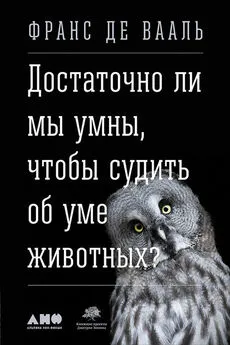

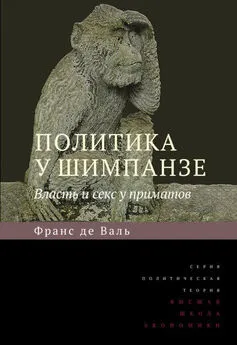
![Франс Вааль - Последнее объятие Мамы [litres]](/books/1075030/frans-vaal-poslednee-obyatie-mamy-litres.webp)
